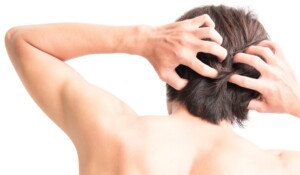
Have you noticed that lately, your dandruff shampoo has lost its effectiveness against your seborrheic dermatitis?
For example, you have flare-ups on your nose and the skin between your eyebrows and eyelids.
Or, you may have flare-ups on your scalp. In either case, there’s a reddish or orange-pink area that itches, maybe stings or burns, and flakes.
For people with seborrheic dermatitis on parts of their body other than the scalp (where it is commonly referred to as just “dandruff”), they are often advised to apply dandruff shampoo and rinse with water.
This is because the mechanism of the condition (overactive sebum production) is the same, whether it’s on your face, back, behind the ears or on the scalp.
“Dandruff occurs when your scalp is oily,” says Dr. Janet Prystowsky, board certified dermatologist in New York, NY, with 30+ years’ experience.
“The excess oil [sebum] becomes food for normal scalp fungus that irritates your scalp and causes white flakes.
If you simply have dry skin, then dandruff shampoo will not help your white flake problem.
Unlike dandruff, dry skin needs more moisturization, so dandruff shampoos only make dry skin worse.
“Besides seborrheic dermatitis and dry skin, bacterial infections can also cause a flaky scalp. While dandruff shampoo won’t hurt, your bacterial infection could get worse in the meantime.”
Dandruff Shampoo No Longer Works for Seborrheic Dermatitis
If this is what you believe has happened to you, it’s probably an illusion. I have seborrheic dermatitis which really flared up while I was under a lot more stress than usual.
During this time I became especially lax at applying the shampoo often enough to control the condition—which occurs only on certain areas of my face.
I ended up with notably reddish, bumpy and flaking skin on my entire nose, cheeks near my nose, a patch of red and flakes on my forehead, and a crusty scaly orange-pink patch on the skin between my brow and eyelid.
This out-of-control seborrheic dermatitis snuck up on me, and before I knew it, these areas itched and burned.
They were so bumpy that when I applied the dandruff shampoo, it did not go on smoothly, and required some elbow work to remove with water, as it tended to collect between all the mini crevasses of the condition.
Right after applying the shampoo, the stinging intensified. So did the redness. It looked and felt worse.
I’d then cease the shampoo applications, but the condition didn’t get better; it persisted.
My mother was asking me what was wrong with my nose.
But every time I put the shampoo on, it stung and itched more, got redder and flakier. I’d back off, but the condition remained.
I then realized that maybe I should just apply the dandruff shampoo EVERY DAY instead of once every several days, and the heck with the burning, itching and residual blueish-green gunk from the shampoo.
After several days I saw an improvement. Fairly quickly, with this consistency, the condition pretty much cleared up.
I might also add, however, that the situation that was causing me tremendous anxiety had also begun resolving.
My skin looks very normal now, and I’ve been faithfully applying the dandruff shampoo every day without fail.
You cannot back off or take breaks from this if you want your seborrheic dermatitis to be controlled.









































